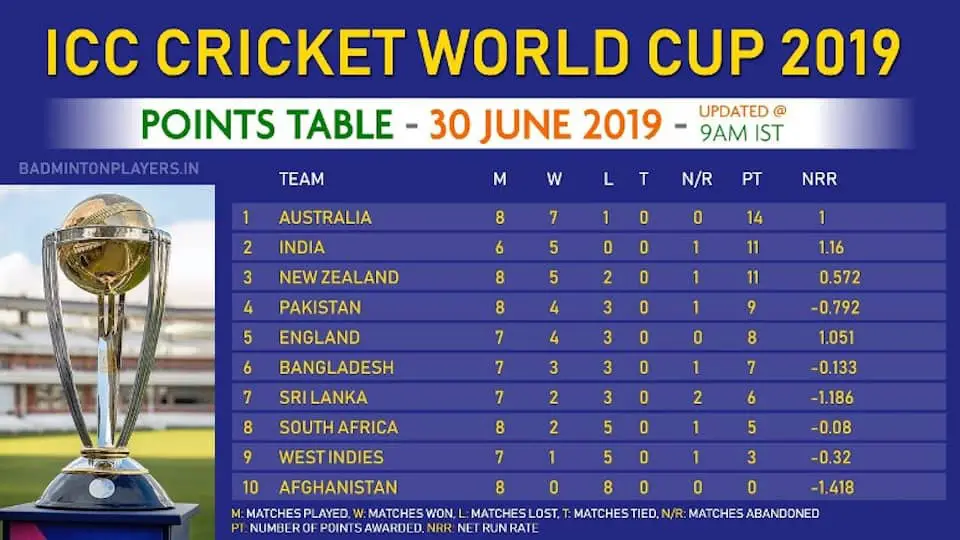You may have heard the term Net Run Rate (NRR) before and wondered what it is and why it is so important.
Net Run Rate (NRR) in cricket is a statistical method of analysing and compare the performance of a team usually during a multi-team tournament. The Net Run Rate plays a critical role to decide which team qualifies for the next round when two or more teams end up with the same number of points.
Here’s how to calculate it, along with some broader information about its use in the professional game.
What is Net Run Rate? (Detailed Explanation)

The Net Run Rate (NRR) is used in various forms of the game to analyse the performance of a team over a given time-period.
Its most common application is in a league table, as a means of differentiating between two teams who are on the same number of points. This is much like how ‘Goal Difference’ is used in football leagues to separate teams who are level on points.
The most common usage of net run rate is often in the Group matches in the Cricket World Cup or other Cricket Tournaments organised by the ICC. It also plays a key role in many of the T20 cricket leagues being played across the world.
How is the Net Run Rate (NRR) Calculated?
There are number of basic equations that you must get your head around in order to be able to calculate the Net Run Rate, and they are as follows.
Firstly, you must calculate the Run Rate of the given team or teams. This is sometimes also known as the Runs Per Over (RPO) and it is calculated by dividing the total runs scored by the number of overs faced.
RUN RATE = TOTAL RUNS SCORED/TOTAL OVERS FACED
In order to establish a team’s Net Run Rate, we must then take this figure and compare it to the score of the opposition. Therefore, in a single match your Net Run Rate is:
NET RUN RATE = YOUR TEAM’S RUN RATE – OPPOSITION’S RUN RATE
So, if we are to take an example. If Team A were to score 250 runs, during a 50 over innings. Their Run Rate would be 5 (250/50). Meanwhile, if their opposition (Team B) scored just 225 runs from their 50 over innings, then their Run Rate would be 4.5.
As a result, the Net Run Rate for Team A would be +0.5. While for Team B, it would be -0.5.
Calculation of the Net Run Rate for the Tournaments

As you can see, from the example above, the Net Run Rate can be used to calculate a team’s performance in a single game, when compared to their opposition. However, this can also be used to measure performance over the entirety of a league-based tournament.
Although, in this situation, the NRR is not a cumulative total of each game’s individual NRR, but an average from across the entire campaign. Therefore, in order to calculate the NRR for a league season, you must apply the following equation:
NET RUN RATE = (TOTAL RUNS SCORED IN ALL MATCHES/TOTAL OVERS FACED IN ALL MATCHES) – (TOTAL RUNS CONCEDED IN ALL MATCHED/TOTAL OVERS BOWLED IN ALL MATCHES)
To this end, if Team A had played 18 matches in their league season (with every innings going the full 50 overs) then the equation might look something like this:
(4500 RUNS SCORED/900 OVERS FACED) – (3600 RUNS CONCEDED/900 OVERS BOWLED) = NET RUN RATE OF +1
Thankfully, however, there are tools out there to make life easier for you – particularly if mathematics isn’t your strong point. There are online calculators which can do the maths for you, meaning you can focus on the cricket.
Exceptions to the Calculation of Net Run Rate (NRR)
So far, you might be wondering what all the fuss is about. Although you have to do a bit of maths, it’s all pretty straightforward and easy to calculate, isn’t it?
Well, there are a few mitigating circumstances that can have an impact on the calculation of the Net Run Rate in Cricket. For example, if a team is bowled out before the end of their maximum allotted overs, then the number of overs used to calculate the NRR is the maximum number it could have been rather than the actual number of overs faced.
Although, if there is a reduction in the number of overs to be played (due to a weather disruption, for example) then the new maximum number of overs that could be played is used – not the original. So, should a rain delay mean that 20 overs of a day’s play were lost, in a One-Day 50 over game, then the maximum total of overs used to calculate each side’s NRR would be 30 – having lost 10 each.
In the case that rain was to affect the day’s play to the extent that there was no way to determine the outcome (meaning Team B were unable to bat at all) then none of the runs scored, even before play stopped, would be factored into overall NRRs for the competition.
And finally, if a match was affected by rain, but its outcome was decided by the Duckworth Lewis Method, then the NRR of both teams is calculated based on the number of overs faced by Team B – regardless of how many overs Team A faced.
How does Duckworth-Lewis affect the Net Run Rate Calculation?

You might now be presented with another question, though. And that is; ‘what is the Duckworth Lewis Method?’
In brief, the Duckworth Lewis is used to calculate the outcome of a game in the case that Team B is able to bat for a period but unable to complete their innings in the maximum number of overs allowed, as a result of bad weather.
The formula is used to calculate the Par Score of each side and takes into account the number of overs played or left to plat, and the number of wickets already lost.
While much more complicated to work out than the NRR, it is less important to know how to formulate the Duckworth Lewis than it is to understand its implications with regards to working out a team’s NRR.
The important thing to know, is that when calculating the NRR for a match which has been affected by rain (and where the Duckworth Lewis Method has been used to determine a result) then both teams’ NRR is based off the total number of overs faced by Team B.
Issues with the Net Run Rate (NRR) System
The Net Run Rate System requires you to consider several different factors. Obviously, because there are so many things to consider, and a number of different variations on the rules depending on everything from the format of the game, to the weather conditions it is played in, there are a number of people who want to scrap the NRR.
1. Net Run Rate Adversly affects teams that don’t Play Full 50 Overs
Teams that are unable to bat their full quota of 50 overs, get affected drastically on their Net Run Rate. This is because if a team is all out, full 50 overs are considered in calculating their Net Run Rate. This is particularly challenging for teams in bigger tournaments such as the ICC Cricket World Cup.
An excellent example of this can be seen during the 2019 Cricket World Cup. Since Pakistan couldn’t finish their 50 overs in a match against West Indies, the drop in their Net Run Rate was so significant that it couldn’t recover despite victories against Afghanistan, Bangladesh, and even against both the world cup finalists – England and New Zealand!
2. Lack of Correlation with Victory and Close-Calls
Perhaps one of the biggest issues with the Net Run Rate is that it is not linked with a team winning a match.
This means, a team that has a better Net Run Rate can end up winning a match and still experience a drop in position in the points table when another team (playing a different match) may gain in its Net Run Rate even if they have lost the match.
Furthermore, the difference in the victory margin in terms of wickets has no impact on the Net Run Rate. Since Net Run Rate only considers the run rates of the team which are based on the batting run rates, it bares no impact on closely fought matches where teams win by 1 or 2 wickets in hand!
This article on Why Net Run Rate Doesn’t Work explains this concept with examples.
3. The Net Run Rate doesn’t consider the Wickets Lost
One of the biggest omissions while calculating the Net Run Rate is the wickets. Since, the number of wickets a team has lost is an important factor in determining how well a team has performed, often Net Run Rate gets criticised for this lacunae.
What’s more, many critics would prefer a system which (like the Duckworth Lewis) takes into account the number of wickets lost. This would give credit to teams with good bowling outfits, but who might not be as strong at batting, a better reflection in league tables. In its current guise, NRR prioritises batting over bowling as a measure of success.
4. Complexity of Calculation
Net Run Rate is also often considered a bit difficult to calculate and keep track of. In fact, the very reason you are reading this article is because the concept is not easy to understand sometimes, but easy to forget about.
The grievances aren’t simply with the logistics of having to figure out the maths, but often opponents to this method of analysis are concerned with the impact of that the perception and understanding of the rules will have on audiences watching the game, both on TV and in stadia.
Alternatives to the Net Run Rate (NRR)
Many critics do not wish to do away with the system in its entirety. After all, it is a relatively accurate means of measuring a team’s overall performance and consistency, particularly in a tournament setting.
Some, however, would prefer to see the NRR calculated as an average rather than accumulative total throughout a tournament. This would mean that each game would have an equal weighting, no matter its length or the outside conditions (such as weather) which might have affected its outcome.
For example, a team might have a total NRR throughout the tournament of +0.5. But when each individual match’s NRR is averaged, their score might be +0.6. This was the case in the 1999 Cricket World Cup Group B, where New Zealand progressed to the knock-out stages based on their having a higher total NRR than the West Indies. Even though the West Indies had a higher NRR when the average was calculated from each game rather than their overall tournament score.
Finally, many people believe that the best way to assert which teams should come out on top in the case that they end the tournament on equal numbers of points, is to revert to the outcome when the two played each other head to head.
